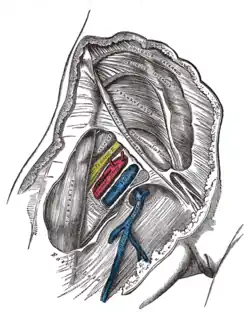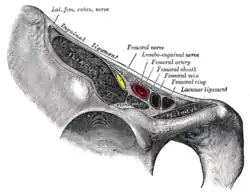Femoral canal
| Femoral canal | |
|---|---|
 Femoral sheath laid open to show its three compartments. (The femoral canal is both visible and labeled [difficult to see label] medial to the femoral vein.) | |
 Structures passing behind the inguinal ligament. The entrance to the femoral canal, the femoral ring, is labeled at right. | |
| Details | |
| Identifiers | |
| Latin | canalis femoralis |
| TA98 | A04.7.03.012 |
| TA2 | 2698 |
| FMA | 22405 |
| Anatomical terminology | |
In human anatomy of the leg, the femoral sheath has three compartments. The lateral compartment contains the femoral artery, the intermediate compartment contains the femoral vein, and the medial and smallest compartment is called the femoral canal. The femoral canal contains efferent lymphatic vessels and a lymph node embedded in a small amount of areolar tissue. It is conical in shape and is about 2 cm long.
Anatomy
The femoral canal is bordered:
- anterosuperiorly by the inguinal ligament
- posteriorly by the pectineal ligament lying anterior to the superior pubic ramus
- Medially by the lacunar ligament
- Laterally by the femoral vein
It contains the lymph node of Cloquet. It should not be confused with the nearby adductor canal.
Clinical significance
The entrance to the femoral canal is the femoral ring, through which bowel can sometimes enter, causing a femoral hernia. Though femoral hernias are rare, their passage through the inflexible femoral ring puts them at particular risk of strangulation, giving them surgical priority.
Physiological significance
The position of the femoral canal medially to the femoral vein is of physiologic importance. The space of the canal allows for the expansion of the femoral vein when venous return from the lower limbs is increased or when increased intra-abdominal pressure (valsalva maneuver) causes a temporary stasis in the venous flow.
See also
References
![]() This article incorporates text in the public domain from page 625 of the 20th edition of Gray's Anatomy (1918)
This article incorporates text in the public domain from page 625 of the 20th edition of Gray's Anatomy (1918)
External links
- antthigh at The Anatomy Lesson by Wesley Norman (Georgetown University) (femoralsheath)
- Diagram at NHS
- The Abdominal Wall from www.med.mun.ca